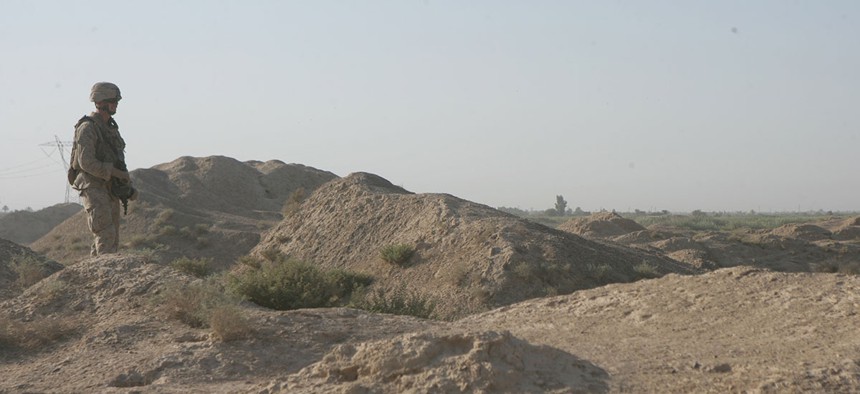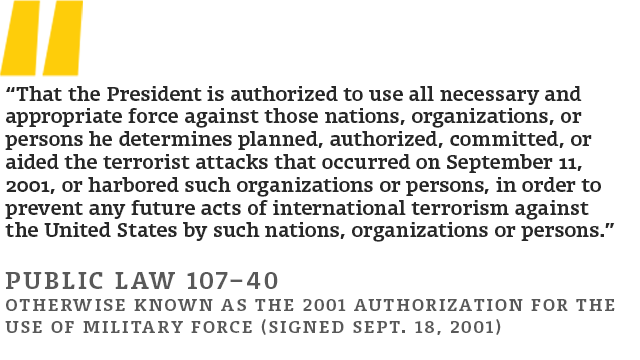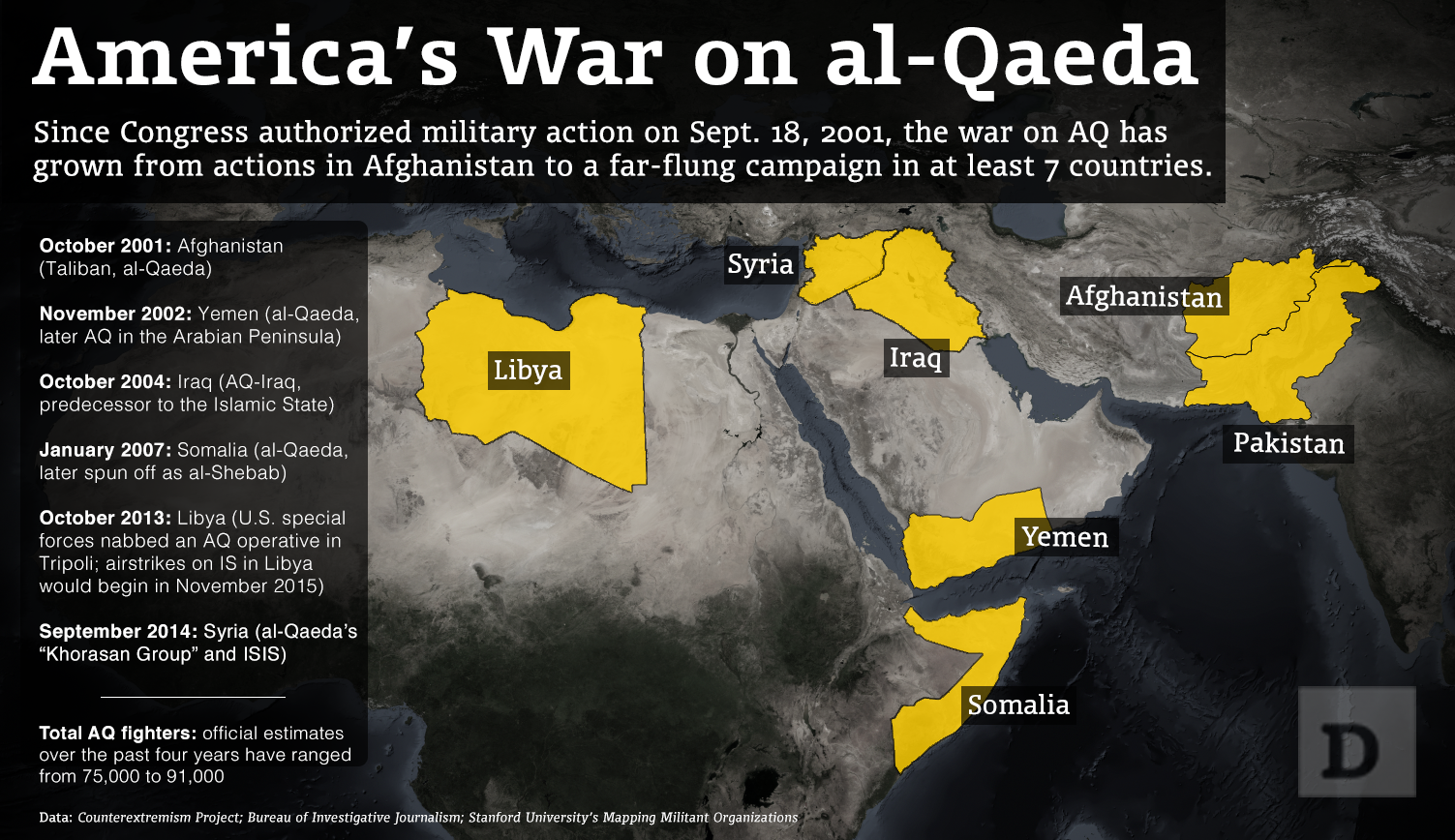
Lance Cpl. Albert F. Hunt/U.S. Marine Corps file photo
This is the War Against al-Qaeda the Next President Will Inherit
Fifteen years after invading Afghanistan in pursuit of the 9/11 attackers, the U.S. is bombing a half-dozen more countries.
On Sept. 18, 2001, Congress authorized U.S. military action against the perpetrators of the 9/11 attacks. But next year, when a new president arrives at the White House, he or she will inherit a war sprawled across seven countries — and beyond.
Just days before the two-year anniversary of the start of U.S.-led airstrikes against the Islamic State group, President Barack Obama cautioned that the campaign is far from over. “It should be clear by now, and no one knows this better than our military leaders, that even as we need to crush ISIL [the Islamic State group] on the battlefield, their military defeat will not be enough,” Obama said Thursday during a rare appearance at the Pentagon.
Al-Qaeda had the attention of U.S. intelligence officials before 9/11, when the group was largely confined to Afghanistan and Pakistan. Fifteen years later, U.S. officials say the loose network of al-Qaeda-linked groups includes between 75,000 to 91,000 fighters, and that’s just in the seven countries where the U.S. has launched attacks against them. (For a full list of countries believed to have either an al-Qaeda or ISIS presence, see below .)
From the beginning, the U.S. has fought the war, in part, under secret rules: on torture , on assassination by airstrike , and more. The latest changes to the Obama administration’s “targeted killing” program became public last week when the White House released updated guidance —known formally as Presidential Policy Guidance, and informally as “the Playbook,” dated May 22, 2013—including a requirement that U.S. intelligence acquire “near certainty” that a strike will not result in unintended deaths to nearby civilians.
The U.S. admitted in July that nearly 2,600 people had been killed in 473 strikes from January 2009 through the end of 2015, according to figures released by the Director of National Intelligence. Notably, those figures do not include strikes in Iraq, Afghanistan or Syria. The DNI report also stated that as few as 64 and as many as 116 of those killed were civilians, an estimate far lower than those documented by groups like the Bureau of Investigative Journalism and the open-source investigators at Airwars —both of whom put the number of civilians killed in U.S. airstrikes in its sprawling war on al-Qaeda at well over 1,000.
The documents’ release came in response to a court order in a lawsuit filed by the American Civil Liberties Union, whose Deputy Legal Director Jameel Jaffer called it “a timely reminder of the breadth of the powers that will soon be in the hands of another president.”
But for all the changes, the war is still being waged under the same 2001 authorization. Just last week, the Pentagon cited it as the legal reason it could conduct airstrikes against the Islamic State group in Libya.

“So long as [al-Qaeda’s] twisted ideology persists and drives people to violence, then groups like ISIL will keep emerging,” Obama said Thursday. “And the international community will continue to be at risk in getting sucked into the kind of global whack-a-mole, where we're always reacting to the latest threat or a lone actor.”
With past as prologue for the next commander-in-chief, here’s a short history of the war against al-Qaeda that the next U.S. president will inherit.

Afghanistan and Pakistan: 2001-present
We begin in Afghanistan, where the U.S. first sent special operators to dismantle the Taliban regime in October 2001. (AQ leader Osama bin Laden had moved his primary base of operations there after 1998 strikes flushed him from Sudan.) In late 2001, a chase into the Tora Bora mountains is believed to have pushed bin Laden to Pakistan.
Three years later, the U.S. began launching drone strikes targeting al-Qaeda-linked extremists in Pakistan. The first known strike took place on June 17, 2004.
In 2014, the U.S. began withdrawing thousands of troops, allowing the Taliban to regain prominence and territory. In early 2016, the U.S. began targeting the Islamic State’s so-called Khorasan affiliate, based largely in eastern Nangarhar province, a move that eventually led Obama to broaden his public justifications for conducting airstrikes in Afghanistan beyond self-defense.
Growing impatient with a long-delayed peace process with the Taliban, the White House directed a May 2016 airstrike that killed former Taliban leader Mullah Mansour inside Pakistan. This signaled that crossing the Afghan border would no longer keep the Taliban safe from U.S. military drone strikes, to say nothing of CIA action.
Today, the Afghanistan Taliban are believed to number up to 25,000 people. The Islamic State group, via its Khorasan affiliate, are believed to have close to 1,000 people in the country, though officials said in April that could be as high as 3,000. There’s also the al-Qaeda-linked Pakistan-based Sunni militants of Lashkar-e-Taiba and the Haqqani network, both plaguing Kabul’s long war. Altogether, both groups total probably less than 5,000—but that estimate is from 2012.
Yemen: 2002-present
Moving over to Yemen, where the first known American drone strike took place on November 3, 2002, killing an estimated six al-Qaeda fighters. U.S. operations in Yemen would remain relatively quiet until 2009, when the Obama administration began what turned out to be more than 230 drone strikes over the next seven years on fighters from the Arabian Peninsula branch of al-Qaeda (formed in 2007 when al-Qaeda Yemen merged with al-Qaeda Saudi Arabia).
AQAP is believed to have between 1,000 to 3,000 fighters, according to estimates from 2014. ISIS also claims a presence in Yemen, though recent estimates put their ranks in the low hundreds.
Iraq: 2004-present
The 2003 invasion of Iraq uncorked various violent tensions, and the U.S. quickly found itself embroiled in insurgency. Al-Qaeda effectively launched its Iraq affiliate when its leader at the time, Abu Musab Al-Zarqawi, pledged allegiance to Osama bin Laden on October 17, 2004.
Over more than a half-decade of bloody resistance, the group was decimated by targeted raids driven by American intelligence in Iraq. But in the months after the U.S. withdrew from the country in 2011, al-Qaeda’s Iraq branch re-emerged and later broke with al-Qaeda to form the Islamic State group in 2014.
ISIS is believed to have anywhere from 19,000 to 25,000 fighters, according to the most recent U.S. government estimate.
Somalia: 2007-present
For nearly a decade, the U.S. military has carried out offensive operations against al-Qaeda-aligned fighters in Somalia, including a raid involving special operations troops on January 7, 2007. However, the first drone strike wasn’t carried out until June 23, 2011.
More than two dozen suspected drone strikes would hit regions inside Somalia over the next five years—including one strike in early September 2014 that killed Ahmed Abdi Godane, the leader of the al-Qaeda-linked al-Shebab militants.
In 2015, Shebab was believed to have between 7,000 and 9,000 fighters.
Libya: 2013-present
The power vacuum left in Libya after the 2011 Arab Spring uprising and the death of dictator Col. Muammar Gaddafi allowed al-Qaeda-aligned fighters to flourish in lawless Libya. But U.S. military action inside the country would seize headlines early in October 2013 when special operators snagged Abu Anas al Libi, known for playing a part in the 1998 bombings of U.S. embassies in Kenya and Tanzania, from the streets of Tripoli.
The U.S. carried out airstrikes against ISIS-aligned fighters in Libya in November 2015 in an operation believed to have killed the group’s Libyan chief, Abu Nabil. The Obama administration would also strike ISIS targets in Libya the following February, possibly killing more than three-dozen fighters.
But on August 1, 2016, Obama formally authorized a new campaign of airstrikes against ISIS in Libya under the banner of assisting forces from the newly-formed Government of National Accord. A variety of ISIS- or al-Qaeda-affiliated groups remain in Libya,
including fighters from the Ansar al-Sharia ( numbering as many as 5,000 in 2014) and al-Qaeda in the Islamic Maghreb ( estimated to number as many as 1,000 in 2016).
IS’ strength in Libya could be as few as several hundred, or as many as 7,000.
Syria: 2014-present
The U.S. Navy lobbed the first American strikes against al-Qaeda in Syria on September 22, 2014, when it fired 47 Tomahawk cruise missiles on allegedly elite fighters from the Khorasan Group in northwestern Idlib governorate. Since then, the U.S. military has targeted fighters from al-Qaeda’s Nusra Front in Syria, as well as ISIS fighters.
Whereas ISIS was estimated at as many as 25,000, Nusra is believed to have had as many as 10,000 in 2015 (15,000 in 2013, before the rise of ISIS).
Estimates of fighters per group
Taliban: 25,000
IS-Khorasan: 1,000 to 3,000
Lashkar-e-Taiba/Haqqani: nearly 5,000
AQAP: 1,000 to 3,000
IS-Yemen: nearly 200
ISIS: 19,000 to 25,000
Shebab: 7,000 to 9,000
Nusra: 10,000
Ansar al-Sharia: 5,000
AQIM: 1,000
IS-Libya: 1,000 to 7,000
Total: 75,200 to 91,200
Where is AQ today? Afghanistan, Algeria, Bangladesh, Burma, Djibouti, Ethiopia, France, India, Kashmir, Kenya, Lebanon, Libya, Mali, Mauritania, Niger, Pakistan, Saudi Arabia, Somalia, Syria, Tunisia, and Yemen.
Where is ISIS today? Iraq, Syria, Egypt, Libya, Algeria, Yemen, Saudi Arabia, Nigeria, Afghanistan, Pakistan, and the North Caucasus. Beyond this, ISIS has attacked in Turkey, Lebanon, France, Belgium, Bangladesh, Indonesia, Malaysia, Tunisia, and Kuwait.
NEXT STORY: How Not to Plan for ‘The Day After’ In Libya






